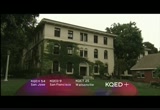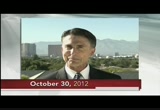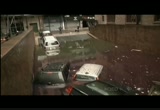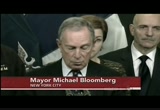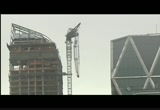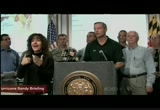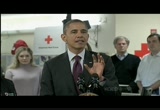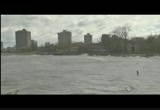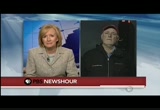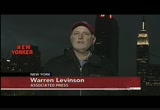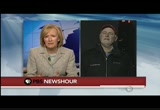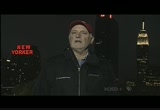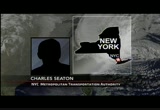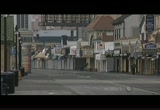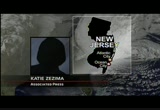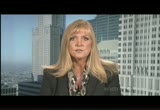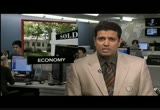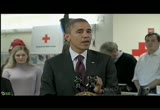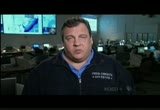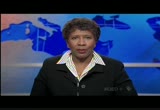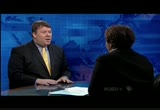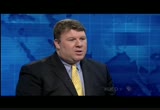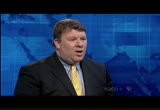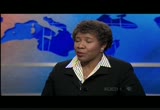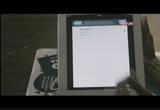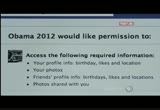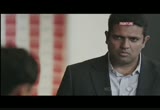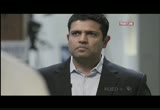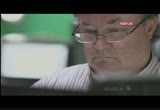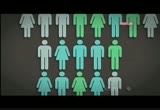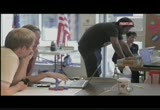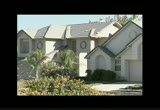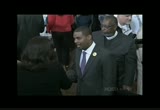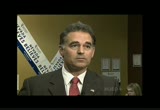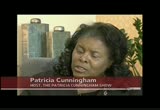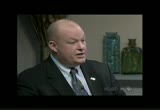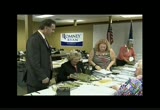tv PBS News Hour PBS October 31, 2012 12:00am-1:00am PDT
12:00 am
captioning sponsored by macneil/lehrer productions the death toll is climbing and more than eight million people are without power. one day after the most powerful storm to hit the northeast in decade good evening. i'm judy wood rough. >> ifill: and i'm gwen ifill. on the newshour tonight, we get the latest on the damage estimated in the tens of billions ofollars, and the challenges still t ahead. >> woodruff: then we assess the effect of the super storm on the presidential race. as mitt romneyll collected relif supplies and president obama went to the headquarters of the red cross. >> ifill: in his second story
12:01 am
voters online, harry veen veen goes to ohio where the campaigns have positions forming digital armies. >> sreenivasan: it's an endless feedback loop channeling datati back to the campaigns for them to learn even more about it and refine their pitches further. it's the campaign strategy of the future. >> woodruff: and a battle ground dispatch from nevada. mitch fox of the las vegas pbs reports on a tight contest in a newly created congressionales district. mplexities ofthe this race read like a novel. money, aggressionive attacks. a famous family name. even a potential bankruptciymp looming. it's all playing out in a district that covers half the state.mi >> woodruff: that's all ahead on tonight's newshour. major funding for the pbs newshour has been provided by: >> computing surrounds us. sometimes it's obvious and sometimes it's very surprising in where you find it
12:02 am
soon, computing intelligence in unexpected places will change our lives in truly profound ways. technology can provide customized experiences tailored to individual consumer preferences, igniting a world of possibilities from the inside out. sponsoring tomorrow, starts today. and by the alfred p. sloan foundation. supporting scien, technology, and improved economic performance and financialno literacy in the 21st century. and with the ongoing support of these institutions and foundations. and... friends of the newshour. and... this program was made possible by the corporation for public broadcasting. and by contributions to your pbs station from viewers like you. thank you.
12:03 am
>> woodruff: the giant hybrid storm named sandy left a growing toll today. officials reported at least 39 people killed, and $20 billion or more in damage. the nation's most populous city and its surroundings were at the epicenter. new york is a city in shock today, even deserted in places after a night of fear, fire and floods. a record storm surge of 13 feet poured into parts of lower manhattan, brooklyn, and queens as sandy hit. the rush of water closed major commuter tunnels linking manhattan with otherboros contributing to the worst damage to the subway system in its 108 years. >> last night we could look down this street here and weaw the river coming toward us and it actually looked like something
12:04 am
out of ao movie. it was unbelievable. >> woodrf: equally unbelievable, winds of at least: 80 miles an hour blew out the bright lights that usually dominate the manhattan skyline. some one million homes and businesses i and around the city lost power. today mayor michael bloomberg appealed for understanding amid warnings it could take days to restore all transit service and power. >> we have begun the work of clearing and reopening bridges and roadways both of which will take some time. and the best way new yorkers cae help us get this done quickly is to stay off the roads. the work of getting our mass transit grid and our power grid restored, however, is going to take morein time and a lot of patience. >> woodruff: but no amount of patients would make good some losses. in queens fire destroyed at least 100 homes and forced firefighters to trudge through
12:05 am
waist-deep water to rescue the trapped. elsewhere, crashing waves hurled a tanker ship ashore on statten island. flooding also swept up cars from city streets and carried them away. and water rushed into the construction site where the world trade center once stood. asigh winds store away the facade of buildings. the wind alsoas blew a construction crane from its per much near a luxury high rise in midtown manhattan where it dangled today. thousands of people were forced to surrounding building. and200 patients had to be carried from new york university to hospital overnight after its back-up generator failed. this morning many people were still trying to take it all in. >> was never really like20 raing that hard. the wind wasn't blowinghat hard last night either. just to see how much happened
12:06 am
with even not a lot of wind, not a lot of rain is crazy. >> woodruff: the storm kept all three new york area airports closed today. things were quiet on wall street as the weather shut down the new york stock exchange for a second straight day. something that last happened in 1888. new york governor andrew cuomo struggled tod to sum up all that the storm had done. >> i've been involved in disaster mitigation l across the country when i worked in the federal government. i've seen all types of disasters. i have to tell you what i saw last night in downtown manhattan, what went on on the south shore of long island were some of the worst conditions that i had seen. >> woodruff: like new york, new jersey was also declared a federal disaster area. >> the level of devastation at unthinkable.ore is >> woodruff: by the time sandy
12:07 am
made land fall, it had been downgraded from a hurricane. but governor chris christ said today the distinction made little difference to badly damaged beach towns. >> those out there who are facing loss, devaation, and a heart-breaking reality that your home may be gone, we're with you. we have a long road ahead of us but i have complete confidencede we're going to come out of this better and stronger than before. >> woodruff: there will be much to rebuild. the storm destroyed a large section of the famed atlantic city board walk and farther north 1,000 people had to flee their homes after the water charged over a burm. some people had to be rescued late last night in a town after failing to evacuate. >> i was scared i was going to drown. it was just crazy. i had a hard time getting out of my house. >> reporter: water went up to your neck. >> yes and sometimes over my head.
12:08 am
>> woodruff: the giant storm's reach also extended up and down the east coast and far inland. to the north, strong winds and damage in new england. sparks flew from downed power lis in westport,s massachusetts. in maryland, a power outage at a water treatment plant sent millions of gallons of storm water and sewage flowing into a river in howard county. still, governor martin o'malley said it was a pleasant surprise the state didn't have worse damage. >> i'm feeling a lot better night.han i was last before this storm made land fall. i mean it' clear that we were fortunate to have been on the weaker side of this storm. >> woodruff: in washington d.c.i federal government offices and public schools were closed for a second day. public transit was shut down s through the morning but reopened in the early afternoon. and downed trees and branches
12:09 am
littered grounds near the u.s. capitol d across the national mall. president obama visited the red cross national headquarters and warned those still in the storm's path to remain vigilant. >> this storm is not yet over. we've gotten brief gs from the national hurricane center. it is stillgs moving north. there are still communities that could be affected. so i want to emphasize there's still risks of flooding. there are still risks of downed power lines, risks of high winds, and so it is very important for the public to continue to monitor the situation in your local community, listen to state and local officials. >> woodruff: the warning included especially pennsylvania where the rain kept falling and flood waters kept rising today. and where the storm already passed, clean-up was the order of the day with first light utility crews from across the countryegan working to restoreor power to millions of people. >> we're really lucky to have,
12:10 am
you know, everybody safe and have the crews already here getting us fixed up. >> woodruff: in parts of appalachia, the problem was snow. the hurricane dumped up to ahe foot of it after merging with a cold front catching some people off guard.er >> i was't ready for itdyither. woodruff: meanwhile in the midwest, the storm's power stretched all the way to chicago as waves crashed along the shores of lake michigan. the windy city also got gusts up tosh 60 miles an hour especially challenging for cyclists like this one. >> it's really tough going north. it's very usey going south. you don't even have to pedal. >> woodruff: those same conditions were felt in parts of withgan and wisconsin voluntary evacuations in some towns. the weather also scrambled air travel, radiating out from the northeast. reagan national in wahington and other airports were
12:11 am
practically deserted after thohiands of flights were canceled. af at sea, the 63-year-old captain from aea replica of the h.m.s. bounty was still missing omter his ship sank off cape hatteras north carolina. now on the ground reports beginning with the situation in new york city. warren levinson is with the associated press and he joins me now. welcome. so we just reported some of the statistics we've seen some pictures, but tell us what you're seeing with your own eyes. >> well, judy, what you're seeing around new york is a city that just looks paralyzed. what's interesting is really what we can't see which is the kindf damage that the storm f rge has wrought underground. so much o what we depend on heren new york isyo underground. electrical lines. subway lines. steam lines. that was inundated with salt water. we really don't know how long it ll be before we get to resume
12:12 am
our regular lives once thatl irastructure gets put back.ru you saw people walking around today kind of aimlessly because there's no transit. so if you want to get anywhere, you have to walk or ride a bike and if you're in a car or a taxi, you sort of take your life in your hands as there are a lot of street lights out. >> woodruff: how much of the city is impacted? is it the entire city affected by these disruptions? >> l of the city is affected by these disruptions. when you shut down the entire subway system, you're shutting down the main means of transportation for the vast majority of notof only new yorks but people who come to visit new york. we also have had for a while shut downs of the bridges and tunnels. most of them are open although a couple of tunnels remain closed because they are underwater. just amazing to see the image of all of that water flowing in, for instance, to the brooklyn battery tunnel. >> woodruff: how are people dealing with this? new yorkers, we think of them as
12:13 am
a pretty tough lot. how are they cong? >> denial is a really big help. it's the sort of... it's when you first get hit, judy, the first thing, what do you think? you think, oh, that wasn't so bad. but as time go on and as, you know, you start to feel the effects,t will be a problem. it will be an economic problem. ll will be an emotional problem. we still really don't know.we we're still feeling the full effects. we're still getting to the full effects here. >> woodruff: i don't know you've been able to actually get out, walk around. are some images that stay with you? >> the images that stay with me, i'll give you a couple. last night coming out from a mid-town office and looking south and seeingar really nothig because the power was out, so much of the power was out to our south, that you'resed to this vibrant city staring at you. it was invisible in the dark asecause so many of the lights were off. i'll give you ather one which
12:14 am
was over by the big substation that went outth on east 14th street thismorning. people didn't have television. they didn't have internet. and somebody had taken his big portae rador and put it on the second floor in his window when the governor was giving a briefing. you had a knot of people like aa semicircle of people standing around it listening for what's the latest information. it was let's go back to 1927 or something. >> woodruff: are people...ell, speaking of that, are people comparing this to anything else they've experienced? >> there's some comparison to the last stor.. 14 months ago, irene. that was when the subways were shut down. but the difference was the subways ultitely weren't damagedded. so they got pretty much right back into... right back into work. you know, it's interesting.e e're not getreng g the 9/11 comparisons which is really the last thing that fuy afycted everybody in theed city.
12:15 am
but you're not really hearing that. the comparison that came up, for instance, the new york stock ex-closed for weather two days in a row. the last time they did that was the blizzard of 1888. nobody around here meers thehe blizza of 1888 so there's not a lot of talk about, we look back and remember that big old blizzard. >> woodruru owe understand the stock exchange is open againnd tomorrow. what about work in general? are people expecting to go back toork, to get any semblance of life back to normal? >> tomorrow will be a really interesting day becauseo i think after two days and after the weather kind of gets back to normal, you will get people feeling antsy. you will get them wanting to get out and also too get out and make a living. it's been interesting to see. most of the shops have been closed as you walk around the streets. eventually there's going to be this demand to get supplies, to get food, to just be social. and so as the week wears on, it will be really interesting to see people try to resume their
12:16 am
lives without the kind of things that they really need which is, you know, electricity, lights, transportation. >> woodruff: well, it's a big blow to a big city. warren levinson, ankan you very much. >> you bet, judy. >> ifill: and to two more takes on the storm from a transit official in new york and a reporter on the new jersey shore. ray suarez talked to them by phone earlier today. suarez: mr. seaton, welcome to the program. your agency runs a tremendous array of services: commuter rail, rapid transit, buses, bridges and tunnels. how long before you think you have a full assessment of the damage? >> aually, for theua subway and for the rail, assessment is ndill u terway. bridges eorept fl two of them, were reot ned today at noon after a full inspection, a safety inspection. everything was good to go. >> suarez: are any of new york's extensive subway system runniod
12:17 am
at th point? >> no subway, no commuterail. we're starting buses now. we're ramping up buses for 5:00 start today. and we will nearly a full schedule of buses, bus service tomorrow. >> suarez: the pictures people across the country saw overnight, subway stations underneath water, dirty, salty water. probably h them wondering how do you get all that out. >> we pump it out. we have three pump trains. sy have 300 pumps throughout the stem. we have a vast array of portable pumps so we try to work onne or two tubes at a time. actually a couple of these tubes water filled all the way to thec ceiling. >> suarez: is the nature of the water itself going to complicate fixing and then running an electric rail system? >>ctactually, salt water isac extremely corrosive. what we tried to do this time and what we actually did was we deenergized the third rail and deenergized all the electric circuits in the tube prior to the storm's arrival, prior to
12:18 am
the arrival of the surge. we are hoping that that a will lessen some of the damage. however after the water is pumped out, wee will to a full spection and take out components, clean them, replace them or repair them as needed.s then we will begin a lengthy process. >> suarez: that sounds like a really big job. wheyowill pru have a prediction for the millions of peoplell who use your system as tohen it will be up and running? >> difficult to say. it will be a couple of days atto least. we're working as quickly as we can. actually, we would not have been able to do it as quickly as we will if we had not curtailed service on sunday. >> suarez: new york city is after all built on a cluster of islands. people need to get across bridges, over rivers. will you lay on ext buses to b get people where they need to go? >> we'll probably be bringing subway service in incrementally and looking to supplement that with our bus service. >> suarezagain, sir, how long before you're able to moveag lae
12:19 am
numbers of people around? >> remember, we moved 2.5 million people around every day eust on buses alone. subways are another 5.5 milon. right now we're working as. hard as we can to get at least somes of that subway service back up. so far we don't have a... we're still pumping out water. we're still in thee' assessment section and repair phase. >> suarez: charles seaton of new york's metropolitan transportation authority, thanks for joining us. >> thank you, ray. takeare. >> suarez: i'm now joined by kate zezima of the associated press who rode out the storm on the new jersey coast line. kate, welcome to the program. all that water that was pushed in lanby the storm and the surge tide, is it still around? >> it is.by it is certainly not to the extent that it was last night. atlantic city last night. you looklautside of the hotel and there was about four feetoof water around 10:00 last night. waking up this morning, it was all gone. but that's not to say it's completely gone.
12:20 am
there are still neighborhoods where there's quite a bit of water. i'm actually in ocean citynew jersey, right now where there is a lot ofl water. there's a lot of water left on island. ninth streetwhich is a main street down by the board walk is completely flooded as are a few of the other streets ins thein downtown. >> suarez: did most people heed governor christie's request and those cities? >> in atlantic city, yes, they did. you know, there were a few people who didstay anddi who did shelter either at their homes or at one of the last resort shelters that they had in atlantic city. here in ocean city, it actually looks like quite a few people stayed. they're not letting people on the island unless you're with the press or you have a pressing need to get back. buthose who did stbu, i saw a number of people jogging on the board walk today. i'm watching a family ride theis bikes down the street right now. standingre's a lot of hiter and debris from t storm, you know, at leass here right now people seem to be getting back to normal a little
12:21 am
bit. >> hsuarez: give us an idea of what kind of damage there is. there are big, permanent aructures like the hotels: and amusement parks and such. but there are also a lot of smaller homes that people visit every summer what's it look like? >> well, right here in ocean isty right now there is a marina damage.ad a lot there's a cooler that's turnedded over and such. you know, there's some structural damage on the homes. shingles that have come off and siding. in atlantic city there are a number of awnings of restaurants that have been pulled off. but a lot of the ctastrophic damage for homeowns is really unseen. it's flood damage. structurally in atlantic city there is a large piece of the board walk that broke away. and it's aolutely demolished. it's not the board walk that mosol people know where the casinos are but rather it's further down. it was somewhat dilapidated. there were plans to replace it anyway. >> suarez: what about the people
12:22 am
who evacuated? are these communities in a condition where they can come home yet? >> not yet. comeare not allowed to into atlantic city. there's a travel ban into the city. there's still a lot of power line down. there's a lot of debris ili the roads, you know, from those awnings tha fell down. trfic lights fell down. there's a lot of clfin-up to be done. the same goes here in ocean city. there's less debris i've seen but because there's so much water people are not comginack in right b now. >> suarez: kate zezima of the associated press thanks for joining us. >> thank you. woodruff: and our apologies. we did have not photos for mr mr. seaton andks ms. zezima and now the problem for air travelers. >> warner: at least 17,000 flights have been canceled since saturd including nearly 8,di00 today. jean medina is with the airlines for america a trade line that represents the major carriers. ms. medina, give us an update on where air travel stands right
12:23 am
nowhis evening. i mean, how many airports remain hiclosed? how many passengers have had their plans derailed?cl >> well, as you noted a lot of cancellations. we'r slowly working to bring s the network back . the biggest challenge for us right now remains new york. the three largest airports in new york are closed and will be closed for some of tomorrow and perhaps all of tomorrow. and that's a challenge because roughly one third of the u.s air travel goes through the new york airport. back up andhose running will be the biggest challengese others are already up and runnin so airports in philadelphia and washington are beginning to take ervice again which is great a news. >> warner: why is it prove... i know we're only a daynto this, t difficult to reopen new york airports. are these just under water or is there damage? >> well, evaluating damage but laguardia has some water on the runways. that needs to be pumped off. the systems need to be inspected
12:24 am
both the lighting and landing equipment and the navigation equipment needs to be inspectedm j.f.k. will likely open around noon tomorrow. some aircraft will be coming in there and hopefully starting full service again on thursday. newark right now is withou commercial power. once commercial power comes bach on, then the inspect the systemd see where we can begin resuming service there. one of the other bigger challenges is is the public transportation. you know, gettng an airport back up and running is more than just ngtting planes to the airport. it's reallytt a very intricate choreographed ballet between the airlines and the governments and the airports and making sure you can get the workers there. most of the workers at the airport rely on public transportation to get to the airport. so you need to have the teams in place. you need to have the planes in place before you can really get the system back up and running again fully. >> warner: what should passengers who either had their flights canceled or are holding tickets for flights in, say, the
12:25 am
next three days in or tough the northeast to mid atlantic, what should they do? >> first and foremost, be patieou. second, you can always check your carrier's website. they should sign up for alerts from the airlines themselves that they can get direct and up-to-date information about what is happening with th.r flights. airlines have put in pace the waivers so if they want tohe ange their travel, they can do so without penalty. if a flight isn't canceled for weather they can also get a full refund if that's their preference. we're seeinga combination ofei those things happening between customers who opted not to travel and then, of course, people that are still trying to get back home where wherever they've been. >> warner: briefly, i understand too that because all the planes were dispersed from the big new york airports there's a matter of getting them in position? how long will that take? >> yeah, so the... it shouldn't take too long. with a hurricane much like a snowstorm, we knew about it, it was coming.
12:26 am
we were able to plan it in advance. which is why you start seeing cancellations begin on saturday. airlines really don't want to their passengers stranded in an airport. they'd much rather have them wade out the storm safely at their home or a hotel. that's what happened. in addition to canceling flights, they moved their crews and their planes out of harm's way. so that they can quickly recover once service is up and running back at an airport. so you see that the major kairpts will not have planes on the ground while an aircraft is a huge thing it can't endure a huge hit from a hurricane. airlines did a great jobovingov their crew and aircraft out of rm's way and will begrm the process tomorrow and yet today of geing crews and planes in places where we can resume services as quicklyn possible. >> warne thank you. thank you. >> tfill: we've been following hurricane sandy's developments online, where you can watch a slide show of some of the mostfi compelling still photos from the storm.
12:27 am
>> woodruff: still to come on the newshour, a weather delay for the political campaigns; efforts to target voters using digital data; and a closely watched congressional race in nevada. but first, the other news of the day. here's hari sreenivasan. >> sreenivasan: economic damage from hurricane sandy could go far beyond lost property. the forecasting firm i.h.s. global insight projected $10 billion to $30 billion in lost business today. that would be more than half a percentage point of growth in the fourth quarter. at the same time, there's good news on the housing front. the standard and poor's/case shiller index reported home prices increased 2% in august. in outhern afghanistan today, a man wearing an afghan police uniform killed two british troops in helmand province. it aeared to be another in a string of insider attacks by afghan soldiers and police on nato troops.ea at least 53 coalition soldiers have died in the attacks this year. nato is preparing to withdraw most of its combat forces by the end of 2014. those are some of the day's major stories. now, back to gwen. b
12:28 am
>> ifill: we turn to the presidential campaign, which has taken a bit of a pause in sandy's aftermath. with the election only a week away, the devastating east coast storm forced both candidates off the stump today. they focused, instead, on disaster relief, with mitt romney in ohio collecting canned foods and bottled water, and the president making a quick afternoon visit to red cross headquarters in washington. >> the most important msage i have for them is that america is is with you. we are standing behind you, and we are going to do everything we can to help you get back on your feet. sa ifill: romney also spoke of the need to help storm victims.e >> i appreciate your generosity. it's part of the american spirit. the american way to give to people who are in need. and your generosity this morning touches my heart. >> ifill: the romney campaign announced he will resume
12:29 am
campaigning tomorrow. the president will remain off the trail throughsu wednesday. dn spent most of today at the offering federal support to officials in the affected areas. among them, new jersey's republican governor chris christie, a romney supporter who nevertheless heaped praise on the president. >> i have to say thed administration, the president himself, and people a administrator craig few gate have been outstanding with us so far. we have a great partnership with them. i want to thank the president personally for his personal attention to this. >> ifill: the white house announced the president will tour new jersey's storm damage with kristie tomorrow. kristie said today that disaster transcends politics. >> i don't give a damn about election day. it doesn't matter a lick to me. at the moment, i've got much bigger fish to fry than that. so dohe people in the state of new jersey. let the polopicians who are on the ballot worry about election day its not my problem. i'm not dealing with it at the
12:30 am
moment. >> ifill: both candidates sought to strike a delicate balance even as national and battle ground state polls continue to show them locked in a dead hea. it remains unclear what affect sandy will have on next week's election or on the voting that has already begun in several states. the storm forced maryland, washington d.c., andsome coastal areas of north carolina to suspend early voting. but several of the regions hit hardest by power loss and propertydamage don't allow early voting including new jersey, delaware,er pennsylvani, and new york. in battle ground virginia, voters are permitted to use to vote by excuse mail. but the political impact may extend beyond the top of the ticket. in connecticut, home to a tight senate race between republican linda mcmahon and democratic representative chris murphy, hundreds of thousands of homes and businesses were still without power. and tonight's final senate debate in massachusetts was
12:31 am
canceled after frst republicanrs scott brown and then democrat elizabeth warren pulled out because of the storm. but just outside the immediate zone of storm impact, voters co tinue to casttoballots. as sandy continued west and residual winds gusted to 60 miles an hour, voters were stil. lining up at the polls in central ohio. disaster disasters and unanticipated surprises can turn a campaign upside down, especially oneas close as this one. so, with seven days o go, we assess this parteular october surprise with jonathct allen, senior washington correspondent for politico. jonathan, let me name some examples for you. disasters which happened to fall into the middle a of politicf moments. katrina. the 2008 economic collapse. the aurora shootings earlier this year. the hurricane andrew in 1992. that fell in august. how easy is it for a candidate or a politician of any stripe to mishandle that kind of situation? >> i think we've seen in the
12:32 am
past how easy it is mishandle and as a result we'e seeing a much better handling of it right now for w president obama and fr mitt romney and in general from some of the other politicians we've seen on tv and oth o places. i think this is one of the few situations, unfortunately, where basic human decency and good olitics dos tail. the best thing you can do as a political candidate right now is to appear to care more about what's going on on the ground with people who are suffering than you do about your own t election. ideally that's motivated by a real feeling there rather than simply showing it but certainly politicians have learnd lessons from past generations w have seemed insensitive. >> ifill: it's fair to say a lot of thought goes into how to walk that tight rope, how to turn a campaign event into a relief event or how to take an extra day off thetrail. absolutely an a trying toy gauge just what will make you look sensitive without making you look political in looking sensitive. i mean there's a lot of stage
12:33 am
craft that goes into politics. that is what campaign professionanand even politicians are paid to do all the time:vigure out just whatre it is that will translate the right message. by the way that's important for leaders too. it's not just important in campaigning. these guys go out as emissaries all the time, to other countries if you're the president of the united states, for interstate deals, deals with businesses, things like that. r ability to hitlithe righti note with protocol is an important quality. >> ifill: the handling of disasters is a leadership test as much as anything else is what you're saying. >> absolutely. i think candidates spend a lot e, particularly presidential candidates obviously trying to tell people why they should be elected, why they should have that job. this is an opportunity to show why you should have that job particularly for the incumbent president obama, he gets a chance to show it. even mitt romney is able to telegraph messages abgut how he would lead if he were in power simply byhat he does during a crisis like this.ha >> ifill: and yet there is a lot still going on behind the
12:34 am
scenes. i assume that these guys aren't sitting here a week out and until let's just wait this passes. >> that's right. while president obama has been off the campaign trail and mitt romney converted a campaign event today into a rereef event, their surrogates have be out there, ann romney, joe biden, michelle obam bill clinton. their campaigns have continued b to run advertising. we've seensolicitations for contributions not to the obama campaign but to the redso cross from that massive email list that barack obama has. the campaigns were up and running. they're still doing all the things they normally do. there's a little more sensitivity in the stes that are affected by the hharricane but they can't really afford tor pull out, to push the pause button. >> ifill: democrats have been saying that mitt romney during the republican primary debates may have said that he would actually cut back on fema which ma not as unpopular as it once was. >> he said he wanted to move as much of that responsibility to the states and to private
12:35 am
contributions a poible. so he's getting hit for that right now.ib what would mitt romney's fema look like? would it be as well funded as the current organization? there's about $7 billion in the bank right now. if mitt romney and republicans were in control in congress there a question as to how they would handle disaster relief. generally speaking they've not wanted to spend as much money on that. certainly when they do spend money on disaster relief they want to offset it usually meaning cut back on other q services that the government provides in order to pay for it. democrats tend to want to tax a little more for that or add to the deficit because ofhe emergency. >> ifill: chris christie as the governor of new jersey who the president will be traveling with tomorrow looking at hurricane damage, you can only assume that that will be many levels interpretation of that particular meeting. he said he would likehe to reschedule halloween but it's not possible to reschedule an election, is it? >> it is technically possible to reschedule elections on ae
12:36 am
state-by-state basis but i don't think we're going to need that. t date on which the election d is held actually set by federal law ratherhan the constitution. congress could change that datee there's actually provision for, if a state doesn't get it vote in on time,ot bacally for the state legislature to maca a decision about which electors to end to vote for president. so there are actually ways v for that to happen. i just don't think anybody is that the a point right now. >> ifill: if you'reys in massachusetts or connecticut a your constituents don't have power, they're not watching the ads, maybe the voting machines aren't working, sandy couldave a more direct effect. >> i think we're going to have to wait for that week. it will have an effect certainly on the candidates' abilities to communicate their messages in the last days. a lot of candidates will hold back money so that they can barrage voters with ads in the last week.av some of the candidates that have may find out it wasn't a good idea to husband all that money.
12:37 am
perhaps they should have put the money out earlier. obviously nobody could have predicted this. >> ifill: when the peopl get their power back, they will see ads. >> no doubt. ifill: jonathan allen of politico, thanks so much. >> thanks a lot, gwen. >>oodruff: and to the second of our two-part look at the digital campaign. both coodidates are using technology to learn about voters and then target them with advertisements indiays never ayfore possible. i sreenivasan travels to ohio to see how the effort is plhting out there. his report is part of a multi- media partnership with "frontline," american public med's marketplace and prom publica. sreenivasan: here in columbus, ohio, both candidates are fighting hard. i'm going to visit president obama's campaign first. he has digital teams across the country but the one he has in ohio is one of his largest. >> this is a check. email i just sent. landing page. done.
12:38 am
>> sreenivasan: this may look like a traditional campaign team doing traditional field work but they're part of a campaign that'sollected more voter data than any otheredin history. and their volunteers are using a slew of newtools for both data gathering and voter targeting. the g.p.s. in your smart phone is the blue dot i the center. i'm meeting with the digital director for ohio, ashley bryant, a key player in one of the most data hungry campaigns in history. >> these flags are the voters. these are the doors that you can potentially knock on. >> sreenivasan: now anyone who up for the campaign online can download the obama app that comes preloaded with targets anu tailored scripts. they're not just pitching president obama. they're also collecting even more information. >> who do you support f president? and we simply click that buttone they're a strong supporter, a lean supporter. if they're a strong reblican. once that information is tere it's able to be, you know,bl researched and analyzed and figure o what are the buckets?
12:39 am
>> sreenivasan: that's correct buckets for both the romney and obama campaigns the goal is to target voters sufficiently so they divide us into groups called buckets. the mobilization bucket for strong supporters of the candidate. the opposition bucket for those voting for the other guy. no need to spend resources on w them. and the persuasion bucket for those valuable undecideds. and the campaigns create buckets within buckets. t the more data they have, the them.hey can refine details, notes, that person tells me what their most important issue is, do i put that down? >> i would p that in the note cause we know next time when we're building an audience that, you know, joe schmo was a small business owner. you want to make sure he's a part of that audience. >> sreenivasan: the campaign collects even more data through a new organizing tool called dashboard which allows them to pinpoint not just potential voters but potential volunteers.
12:40 am
the people in the mobilization bucket. >> this is our on-line field office and so dshboard is definitely both a social tool but also a reporting tool, a team-building tool. everythg you can think that werye doing off line. we're trying to bring that on to e.e on-line sp sry simple initial sign-up is ing to be your street address, your zip code and tell us the issues that most matter to you and things like z that. so here this also gives you the option of logging in with facebook its a lot easier because facebook already has a lot of your information whether address, etumber, cetera. >> sreenivasan: not to mention who your friends are, your interests and hobbies and anything else this your public profile. wh all that information, campaign is able to build teams of like-mindalled volunteers, latinos for obama,w pacific islanders for obama. sportsmen for obama. all being recruited as part of the obama ground game. they meet online and then gather in the real world.
12:41 am
>> i think we're expecting a few more people who are going to get started so we can keep on with our agenda. >> sreenivasan: this group of volunteers who cared about lesbian, gay, by sexual and transgender issues was preparing to go out and canvass local voters in support of the president. it seems whether it's dashboard or the mobile apps, they serve two purposes: one, to make sure your teams are in communication with one another and another to learn about the voters you're going out and reaching. >> absolutely. we're always going to be collecting information. because that's how, you know, we extend our reach. that's how we can continue to communicate with that person. just one phice call or one ema is not going to get that person to be... to the polls on election day. >> sreenivasan: for years campaigns have dreed of being d able to take the informationi they gather through canvassing and phonenganking, social media, and email groups and match it to
12:42 am
our voters files and the data called by private commercial data brokers to create an enormous, unified database of voter information. this year for the first time ever, the campaigns have that ability. >> now we're at a place where whether you're a field person entering their numbers in in the evening from us collecting information from a facebook st if you're in virginia, if you're in ohio, that's all going to filter into this one platform not only our states canee but our headquarters can see as well. >> sreenivasan: with access to an unprecedent wealth of data, the campaigns can send an issue-related video ad to someone in the persuasion bucket. >> it's time for a new economic patriotism. >> sreenivasan: or send canvassers to solicit donations from someone in the mobilization bucket. >> fired up. ready to go. sreenivasan: it all adds up to a formidable digital army plus president obama has a
12:43 am
four-year head start and more than three times as man m ohio field offices as mitt romney. digital battlefield has no boundary. to see how romney's fighting for ohio, i need to go 700 miles east to campaign headqrters inrt boston. zach move at is romney's digital director. >> essentially the obama has had that significant head start. how do you deal with that challenge? >> we don't judge ourselves based upon the obama campaign because if we did we would judge against a man who has run unopposed for the last year. if we onlyr. rely on the actual television we'll lose this ection. >> sreenivasan: the survey foun. roughly third of the electorate is more difficult to reach by traditional campaign methods. they're the people who spend more of their lives online. he calls these voters off the grid. >> this large off the grid population, who are they? >> we define them by the term of
12:44 am
people who don't watch live televisich anymore. other than sports they choose to live their lives on demand. they primarily watch d.v.r., netflix, they're choosing when they consume tir contet. that's the big difference. it's an astronomical amount of people who dvi not see a tv spoo one in three voters. >> sreenivasan: that works out to over two million off the grid voters in ohio alone. more than enough to swing the presidential election. so if off the grid voters won't come to the ads, the ads will have to come to them. the campaigns find them by following the trail of cookie crumbs. what's a cookie? well, a cookie is an invisible ece of code that gets dropped on your computer when you visit a website. they're there to help companies and advertisers track your movements and learn more about c you. do you clickox news or cnn? huffington post or drudge report? shop for a hummer or aox pus?
12:45 am
the cookies on your commuter record it all. it's valuable information for anyone who wants to sell you something. including a presidential candidate. this year's election is the firsttime the presidential campaigns have been able to take this on-line cookie data and match it with your voter information, social networks and the kind of consumer data gathered by private commercial data brokers. the result is theti clearest mot detailed picture of the electorate the campaigns have ever had. though they'd rather you didn't think about that too much. if you have all these different data points, are you almost getng... if you say off the gridder that's independe in virginia that might be in the indian american sub community, you're getting closer and closer to figuring out who i am, right? >> it's not imperative to know it's yo when mail comes to your house it has your name on it.
12:46 am
very different experience than online. i think that would be people would feel vend, very uncomfortable at this stage, the digital, privacy. >> sreenivasan: once he has h list of targets he sends it to a company he cofounded, an interactive ad agency calledas targeted victory. >> conservative. sreenivasan: its other cofounder and his team of digital detectives follow our on-line footprint and help moffat find key targets like the off tid grers. he gave me a glimpse of how he does it. >> we're buying an audience. we're not concerned with where the ad runs as to who it runs to. that flips the whole kind of mass marketing, you know, traditional on its head. w >> sreenivasan: political operatives had to where to find their most valuable targets. the they have a treasure map that leads right to them: remember cookies those little pieces of code that can be dropped on your browser to record what you do online?
12:47 am
campaigns aren't only buying ads on specific bsites. they're also buying acce to your cookies which tell the campaigns where you go online. this lets them follow you around t intert and hit you witc2 their advertising on whatever websites you visit. and because the campaigns have so much information about us, they can target their ads so specifically that different people in the same household may see totally different ads. and they can measure instantaneously whether the ad hits it target, something television-based campaigns can only dream of. unlike a traditional tv purchase there's a hugepportunity here for you to learn about me on niwhether i see the ad, whetheri interact with the ad or engage with the ad. >> anything like that is feedback that tells the campaign this is the right message or this is not the right message. so that could change, you know, what a campaign decided to deliver in theg future. >> sreenivasan: it's an endless
12:48 am
feedback loop channelin data back to the campaigns for them to learn even more about us and refine their pitches further. it's the campaign strategy of the future. spending on on-line ads in this year's election is projected to reach 160 million dollars. that's a six-foldth increase sie 2008. as we live re and more of our lives online, the imp ortanceref the digital campaign will onlyan grow. on november 6, the election will be over. and the planning for 2016 will begin. campaigns will ome and go every four years. but our data and the digital feedback loop will live on. >> woodruff: fascinating. an and a reminder: big money 2012 airs on "frontline" on most pbsm stations tonight.
12:49 am
>> ifill: finally tonight, we take a look at e campaign for the house of representatives.e few contests are ing watched as closely as the fight for a new congressional seat in battleground nevada. it's a seat both parties wouldin dearly love to win. but as mitch fox of vegas pbs reports, there are no safe bets. his story is part of our new collaboration with public media partners across the country, as we bring you reports from areas that will likely determine the outcome of the election in a series we call battleground dispatches. duringthe la decade the battle s the fastest... nevadaas the fastest-growing state in the nationand picked up an additional seat in congress. voterats enjoy a 13.5% registration advantage in that new district. but before u bet the well funded democratic candidate here is a shoe-in, remember the old adage: all politics is local. the complexitiesees of this race read like a novel. there's big money, aggressionive attacks, a famous family name,
12:50 am
even a potential bankruptciy looming. and it's all playing out in a district that covers half the state. senator stevene horsford is having the fight of his life. down in every poll, sometimes by double digits. because of this man, republican danny tarkanian, the son of legendary u.n.l.v. basketball coach jerry tarkanian. horsford has been appealing to the 55% of voters registered as sprawlingto win this and increasingly diverse district. from its sparsely populated mining communitieses to the densely populated latino and african-american neighborhoods in the northern tip of the las vegas valley. both candidates are spending a lot of time on the road to meet with voters. horsford is currently the majority leader of the state senate. and he has focused his campaign on economic issues. >> what i've heard from the voters is the same thing. with a are we going to do to get
12:51 am
people working and grow the economy? how are we going to address the housing crisis and what are you gointo do togo protect medicare and social security? i have strong positions on those issues. my opponent does not. >> reporter: tarkanian has benefited from his family's well known name here but failed to win an election in three prior attempts at public office. he has his own take on this race. >> i've tried very hard to get out to all the different areas within the community. i've had business h meetings. i've had meetings with business leaders in theti african-americn community talking about businesses who are there and how we can help them get started and expand. at the same time i've been out in areas talking to the onion farmers and some of the ranchers about the issues they're dealing with with workers and so forth. i've tried very hard to be a go representative and good a good understanding of what's r important for those constituent >> reporter: in august the campaign was infused with racial tension when tarkanian seemed to suggest that horsford was relying on his own ethnicity to
12:52 am
win support from african-american voters. while defending himself in front of a gathering of republicans, tarkanian said he could, quote, be like steven horsford who is not doing anything with that community and pretend we're black, end quote. tarkanian apologized and ended up picking up the support of the local naacp president. patricia cunningham is a local talk radio host. >> the tarkanian name is one of the most recognizable names in the history of collegiat basketball. not only is it a recognizable name. it is a name that african-american athletes and their families have embraced because his father reached out to african-american athletes when no other division 1 program or few division 1 programs were willing to open the door. >> reporter: despite the benefit of name recognition, tarkanian is facing growing legal and financial problems that have complicated his campaign and opened him up to criticism. he and his family were recently
12:53 am
hit with a $17 million judgment by the federal depositnsurance corporation or f.d.i.c., because of a failed land deal. >> the f.d.i.c. is moving to seize hisns assets. perhaps his house. >> reporter: a columnist for the las vegas review journal. >> there's no legal or sctical reason that any reasonable person would not have already filed for bankruptcy unless they're running for office and they're afraid of a flyer or a tv ad that says he's actually running for bankruptcy. i believe win or lose he's going to have to file. that presents certain problems. i mean tarkanian will be involved in litigation against the very government that he now is going to be representing assuming he wins. >> reporter: early voting trends are favoring democrats in nevadad and for horsford's part, he is hoping president obama will win the battle ground state and help sweep his congressional campaign to victory as well.s but the race has made democrats nervous. senate mority leader harry
12:54 am
reid has blasted tarkanian for ehe bad land deal. and super pacs are helping to bolster tarkanian's campaign by inundating the air wav with blistering attack ads aimed at horsford. it's one race but it matters to the bigger picture as democrats look to nevada's fourth district as one of the 25 net seats they need to win back the house. in the end, tarkanian is depending on rural voters w tend to be republican and turn out to vote rin greater numbers than thein democrats. haresford is relying on the democratic machine developed by senator reed in nevada. and a voter registration advantage to squeak past his opponent in one of the most closely watched congressional races in the nation. >> ifill: >> ifill: our next battleground dispatch will come from iowa, where the issue of immigration is bubbling to the surface. >> woodruff: again, the major developments of the day. the death toll from sandy
12:55 am
reached 40, and more than eight million people were in the dark. officials in hard-hit new york city warned it could be days before power and transit service are restored. and the storm's destruction kept presidential campaigning on hold. instead, president obama and mitt romney focused on disaster relief. finding a job is hard enough, especially for introverts.es but we have tips in our weekly series ask the headhunter. hari sreenivasan has more. answer your question on finding the perfect job and honing your interview skills on our making sense page page. and just in time for halloween, we've updated our ad maker. now you can put yourself in a political ad starring amerias latest menace, zombies. find the app on the rundown. all that and more is onmeur web site, newshour.pbs.org. judy? >> woodruff: and that's the newshour for tonight. on wednesday, we'll go to wisconsinonwhere the ground gamh could make all the difference in a very tight presidential race. i'm judy woodruff. g >> ifill: and i'm gwen ifl.
12:56 am
we'll see you online and againif here tomorrow evening. thank you, and good night. major funding for the pbs newshour has been provided by:nk >> intel. sponsors ofomorrow. >. the william and flora hewlet foundation, working to solve social and environmental toblems at home and arou world. and with the ongoing support of these institutions and foundations. and... this program was made possible by the corporation for publibroadcasting. and by contributions to your pbs station from viewers like you. thank you.ub captioning sponsored by macneil/lehrer productions captioned by media access group at wgbh access.wgbh.org
242 Views
Uploaded by TV Archive on

 Live Music Archive
Live Music Archive Librivox Free Audio
Librivox Free Audio Metropolitan Museum
Metropolitan Museum Cleveland Museum of Art
Cleveland Museum of Art Internet Arcade
Internet Arcade Console Living Room
Console Living Room Books to Borrow
Books to Borrow Open Library
Open Library TV News
TV News Understanding 9/11
Understanding 9/11